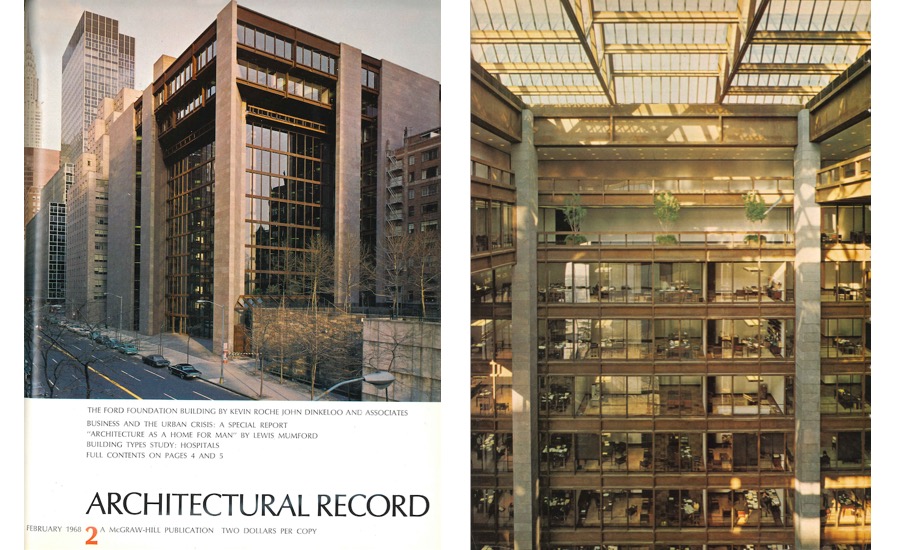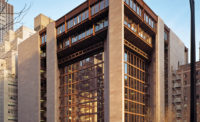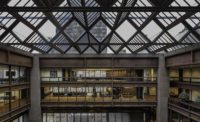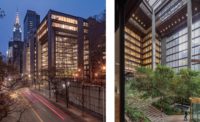The offices are grouped around the court in such a way that it provides both a physical and visual transition between the office space and the world outside. The court serves as a giant return for the conditioned air supplied to the offices, and the offices and corridors that look out on the court have doors that can be opened and slid back. The court also provides a variety of outlook and a constant point of reference. Roche speaks of it as a “living room” for the whole Foundation that provides a sense of community for everyone who works there. The sense of community is certainly present, but the visitor is likely to find that “living room” is too domestic a term. In fact, the space is little short of awe-inspiring, and the sense of organization that is projected is one of ritual, hierarchy, and immense power.
It is difficult to say exactly why this rather unexpected effect should have occurred. One reason may be that, by enclosing the court, Roche has made the entire building essentially four-square; that is the building’s height, length, and width are very similar. The four-square building with an interior court is a traditional symbolic representation of the universe, and as such is an ancient symbol of power, used in religious buildings and palaces. The palace of the king of kings, the temple of the New Jerusalem, the house of the world, are the concepts this shape connotes.
Whatever the reason, the most ordinary aspects of the Foundation building seem charged with special significance. For example, it is very typical corporate symbolism for the top floor to be the executive floor; so typical, in fact, that one ceases to think of this arrangement as symbolic. But, in the Ford Foundation building, the president is visibly above everyone else; one can look up and see him from virtually every point in the building. Not only that, but directly above his head is the office of the Chairman of the Board, whose office is the only one adjoining the court that does not look out on it. The two offices seem to become the visible and invisible manifestations of a mysterious power.
The mysterious effect is heightened by the consistency of interior detailing. The whole building is essentially a collection of executive suites, as the non-executive work of the Foundation is contracted out, through the medium of grants. Each office is done in the same rich palette of subdued natural materials. To the outsider, all the offices appear identical, and the activity of the occupants thus completely unintelligible. The visitor senses, however, that, to the initiate, the fine gradation of office location and sizes has a definite meaning; so that, seeing all, he knows he is excluded.
A final symbolic note is struck by the fact that almost all the metal trim in the building is brass; that is, one knows it is brass, but actually one thinks of it as solid gold, the ancient perquisite of priests and kings. The pervasiveness of gold elevates everything to the status of cult object. Telephones, filing cabinets, typewriter stands, door trim, stair rails, all appear to be of solid gold. Most striking of all are three golden brass doors that lie at the end of a precipitous descent into the basement.
If the building has acquired a symbolic life of its own, however, it is because the Ford Foundation gave its architects the freedom—and the money—to make the design a work of art. And if the result has the effect of picking out and over-emphasizing certain aspects of the Foundation’s organizational character, it is because the design has a tremendous symbolic power that no one could have anticipated before it was built. It is, perhaps, the most important contribution of this building that it demonstrates that a space only modern technology makes possible can command an almost archaic significance.
The experience of the court is also an important one. The design of landscape architect, Dan Kiley, has made it a real garden, and not just a collection of potted plants. In a time of rapidly increasing urbanization, growing densities, and a more and more frenetic pace of life, a garden court of this kind becomes an oasis of tranquility and a point of balance in an uncertain world.
Thus, the design of the Ford Foundation Building, although unique, is also suggestive, and it will be interesting to see if it will have an influence on other buildings. One certainly hopes it will.





Post a comment to this article
Report Abusive Comment